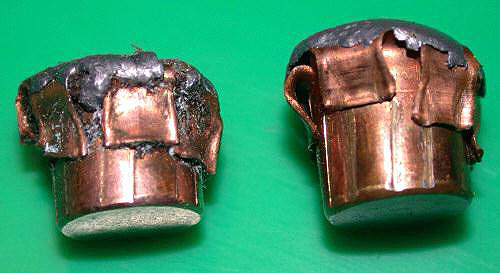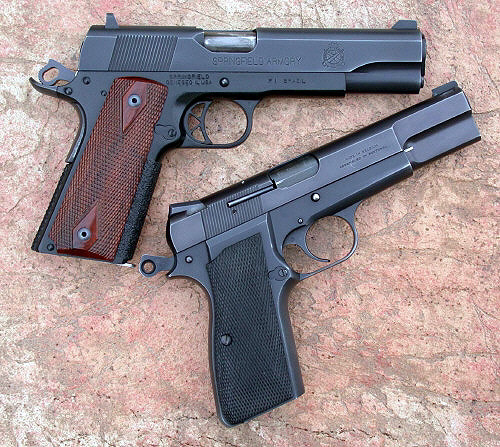The Winchester and Remington rounds performed the same in terms of observed effects.
My 9mm with the rounds mentioned, performed precisely the same with regard to "stopping" the tough little animals. The XTP bullets normally go to about 1.5 x caliber and are not considered aggressive expanders. They are frequently shunned as defense loads because of this and concerns about overpenetration. In the javelina, straight-on broadside shots usually resulted in complete penetration. Angling quartering shots usually showed 12 to 14" penetration and very uniformly expanded 9mm bullets.
Neither my companions nor myself observed any differences in "stopping power" between the 9mm and .45 ACP on these "devil pigs." Yet I know that the .45 with these expanding bullets must leave a larger permanent wound channel. I do not insinuate that the observations made necessarily exactly translate to human targets, but I do note that there absolutely was not the difference in effect that some might lead us to have expected.
The oddity 9mm failure occurred with the Triton Quik-Shok and from the CZ-75. I shot the animal at about 20 yards, angling the shot through the right-side ribcage toward the heart. I was slightly behind the animal and it was a forward angling shot. I fired and the animal simply ran off.
Later that same afternoon, a friend killed what turned out to be the same javelina I'd shot with his forty; I do not remember the load. When it was opened, to our surprise we found that my 9mm Quik-Shok had merely deformed and followed the contours of a rib all the way around, but stopped about 4" from the spine. There was no visible damage other than to the rib the bullet followed.
(Lest anyone think that this phenomenon is limited to 9mm, I'm aware of an incident that occurred years ago in an east Texas town. A 45-toting would-be robber confronted a man working in a bank. He wound up shooting the bank employee during a struggle over the gun. The 230-gr. FMJ bullet hit and broke a rib, but traveled around the outside of the man's body. Despite this painful but ineffective wound, he beat the felon severely with the 1911 pistol.)
Neither the .45's nor the 9mm worked flawlessly with all ammunition. The Quik-Shok load mentioned had worked fine on two other javelinas. The 45-caliber 165-gr. HydraShok failed on all and was discarded, but even the still-popular 230-gr. HydraShok failed to expand once and offered very minimal penetration. As was mentioned earlier, this very well might have been one of the relatively rare cases of a defective or half-loaded round getting out of the factory; I flat do not know but it would explain why the bullet acting like a FMJ solid offered such minimal penetration.
FWIW, the 9mm XTP at about 1240 ft/sec, as well as the Winchester Ranger and 230-gr. Golden Sabers worked consistently well, but to my eyes none performed better than the other. If viewing only the javelina at the moment it was shot, I wouldn't have been able to say whether it had been shot with 9mm or 45 ammo!

Shown are two expanded Hornady 9mm 124-gr. XTP bullets. Both were fired from a Browning Hi Power. The bullet on the left was removed from a javelina. The one on the right was shot into water. The XTP bullet is not known as an aggressively expanding JHP. Yet this bullet at about 1240 ft/sec seems to work just as good as other expanding 9mm loads as well as some of the more popular .45 ACP loads. I do not have a surefire explanation why.
The Texas whitetail deer I've shot with 9mm, 38 Super, .44 Special, .45 Colt and .45 ACP have been pretty uniform in their responses to being shot. A few were instantly incapacitated and never got to their feet; they kicked a bit and then were done. Most jumped, ran a few yards and then keeled over. This is what I've seen time and again with these calibers. I have not used the big magnums considered more appropriate for this type activity so I cannot accurately comment on them. The interesting thing to me is that these smallish 110-lb. animals reacted essentially the same way whether hit with a 124-gr. 9mm XTP at 1240 ft/sec or a handloaded 255-gr. CSWC @ 900 ft/sec from the .45 Colt revolver! Those shot with 230-gr. Golden Sabers handloaded to about 950 ft/sec reacted most similarly to the ones shot with my 38 Super's 147-gr. Golden Saber at just under 1200 ft/sec! (Please note that I am not recommending any of these calibers for "deer hunting." These shots were all at close range and took place over a period of years with more shots passed than taken.) I cannot explain why the effects were almost always so similar, only that this is what was seen, and submit that perhaps there is more to the equation than simply expansion and penetration.
While still a police officer, I was involved in a case in which a small woman ran two city blocks to where my partner and I were handling a different situation. She had been shot through the chest with a .45 ACP 230-gr. FMJ from a 5" Llama pistol. She was not feeling all that good, but was on her feet when the ambulance arrived. I asked her how she ran all that way. She said, "I had to. That mXXXXfuXXer was gonna shoot me again!" It turns out that only her lung (don't remember which) was penetrated and the bullet entered and exited between ribs. Had this happened with a 9mm, some would chalk it up as being about normal for the round. I personally was not surprised.
Several years earlier a ranch where I hunted was overrun with jackrabbits and I shot more than a few with both .45 1911's and my 9mm Browning Hi Power. I "tested" different expanding bullet handloads on these critters, but I needed a baseline so several of the jacks were shot using 115-gr. 9mm FMJ and the traditional 230-gr. FMJ from the 45's. Unless the animals were hit in the forward third of the body, they simply ran off when shot. Sometimes they made it a few yards and other times farther. This was circa 1971 or so. I witnessed this many times and decided that while the then common wisdom decreed that 9mm ball was lacking for self-protection, so was the big 230-gr. 45. To me, if neither would reliably deck a 7-lb. jackrabbit, how could I expect it to do so against a grown man? Yet, another aspect of stopping power was also demonstrated. If the animals were hit in the forward third of the body, the bullet's impact at least had a more immediate effect, i.e., marksmanship counts. Where you put the bullet greatly affects its terminal efficiency.
As an interested layman, I humbly suggest that there may be more to handgun stopping power than is indicated by penetration depths and wound channel measurements. I am not implying that these are not meaningful or of use, but only that there are some things that the homogeneous gelatin might not reveal concerning what makes living animals (including man) cease and desist.
Conclusion and Thoughts on 9mm vs. 45ACP:
- It is my belief based on data from serious researchers that with FMJ, the 45-caliber automatic is more potent than the 9mm. That does not mean that I believe either to be anywhere near the top of the list for self-protection. I do not believe that "they all fall to hardball."
- I do tend to agree that the expanding defensive bullet should penetrate between about 12 and 14". This may be more than required for a straight on, unobstructed chest shot, but it better insures punching the vitals should an intermediate target like an arm get in the way. It would also likely be more effective if the shot was made from the side rather than the front or back.
- I am convinced that the size of the wound channel from an expanded .45 ACP bullet will be larger than that from the 9mm and this should make it more effective, but I have not seen a noticeable difference on animals as mentioned previously. I am equally convinced that gelatin results may or very well may not match what actually occurs in flesh-and-bone targets.
- Probably the most important factor in stopping power (regardless of caliber) remains placement. That this can be difficult to obtain in the life-and-death fight scenario doesn't change the necessity for it if we want the opponent to go down for physical rather than psychological reasons.
- With the best loads, I opine that .45 ACP is a better "man stopper" than 9mm with its best loads, but am not sure of by what margin.
- I do not believe that a 9mm loaded with the better loads is an inadequate defense gun and frequently tote one myself.
- I do not "trust" either the .45 ACP or the 9mm (or any other handgun caliber) to provide the elusive "one shot stop" unless the brain or central nervous system is destroyed.
- I am not convinced that the temporary cavity produced by handgun bullets is totally irrelevant, but I also have no idea of how it may actually contribute. I wish there would be more serious research in this area.
- Either of these calibers with any load may fail to provide the desired results even with a "good" hit. Either may require multiple "good" hits.
- Perhaps either caliber would provide fewer failures if we practiced as much as we worry about our caliber's stopping potential.
I believe that we will continue to see stunning successes and dismal failures with all commonly used defensive handgun calibers including the 9mm and .45 ACP.
An experienced old lawman once told me that a man can be the easiest or the hardest "critter" to put down and the problem is that you never know which you're getting. I think that maybe what he was trying to say is that while a man is an animal, wild animals are not men. If a man is shot and thinks about what has just happened, his human drive to survive may include stopping what he's doing or begging for help. A javelina or deer or bear, etc will not stop until it physically can do nothing else. On the other hand, if a shot man simply reverts to some primordial anger or rage (I'm not sure what to call it) and simply lets his animalistic side come out, he may very well be a most difficult opponent. For 200-lb. animals, we sometimes see even high-powered rifles fail to provide instant "stops." I do not know how to factor in the adrenaline dump that can occur when we're suddenly injured or realizing that we must fight to survive, but I do believe that all of the preceding can play a significant role in the area of stopping power.

 Free Forum Hosting
Free Forum Hosting